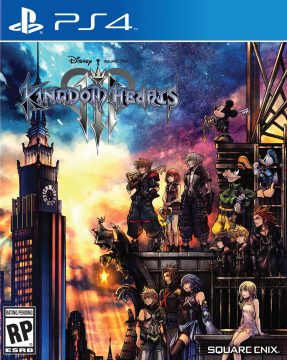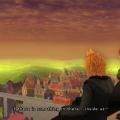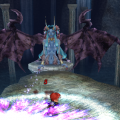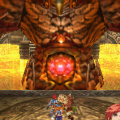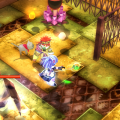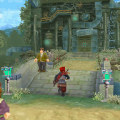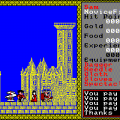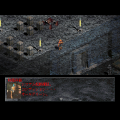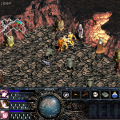- Kingdom Hearts
- Kingdom Hearts: Chain of Memories
- Kingdom Hearts II
- Kingdom Hearts: 358/2 Days
- Kingdom Hearts: Birth By Sleep
- Kingdom Hearts Re:coded
- Kingdom Hearts: Dream Drop Distance
- Kingdom Hearts χ
- Kingdom Hearts 0.2 Birth By Sleep
- Kingdom Hearts III
- Kingdom Hearts: Melody of Memory
- Kingdom Hearts (Miscellaneous)
Finally returning to consoles after over a decade, Kingdom Hearts III serves as the finale for the story arcs started in the portable games. Xehanort is back, and he’s got a new Organization XIII and apocalypse on his mind. In contrast, Sora and the gang are lagging behind, and need to reunite as many of the previous games’ heroes as they can, no matter how impossible their circumstances. With so many characters, there’s no room for a character list, though some previously-unlisted characters will be stepping into greater roles than before.
Now backed by a full console budget for the first time in years, Kingdom Hearts III celebrated with a new engine, new graphical tech, and bigger and fuller Disney worlds. The much-hyped “Kingdom Shader” was introduced to make each world look even more like an animated film than ever, and the developers’ insistence on recreating scenes from Tangled or Frozen with Sora and Goofy loitering in the background is just as impressive as it is silly. There are a few characters who look a little off, especially returning characters like Pete (who looks like an action figure fused inside a plastic suit), but it’s hard to be anything but impressed with the whole graphical package.
And the worlds are just gorgeous, and not just big, but packed with content. Well, “packed” may be a bit much: the game has hardly gone back to Kingdom Hearts 1 levels of puzzles and secrets, but make no mistake, the empty cityscapes of Dream Drop Distance have been left in the dust. There are even NPCs! Lots of them! All voiced! A sidequest adds to the sense of exploration: the “Lucky Emblems,” aka Hidden Mickeys like the ones scattered about the Disney films and parks. You need to photograph them with the game’s new camera to unlock bonuses. Sora’s Flowmotion also returns to help you navigate these massive areas with speed, but the old wall kick climb has been nerfed out and helps Flowmotion feel more appropriate and, for lack of a better term, “under control”. Unfortunately, Metroidvania puzzles are still in the bin, since you can find nearly everything on your first trip, which leaves you with little reason to return to worlds other to find their chests.
One element that helps Kingdom Hearts III stand out was the decision to bring in some of Disney’s original writing teams to expand on the films’ stories in Kingdom Hearts III. Yes, it’s true that Tangled, Frozen, and Pirates of the Caribbean: At World’s End are here in simplistic recreations of the original plot, but other worlds, like the ones for Toy Story, Monster’s Inc, and Big Hero 6 get sequels that feel better than any of Kingdom Hearts‘ steps in those directions in the past. This is also the first Kingdom Hearts game to feature Pixar worlds, and it’s fascinating to compare Pixar’s pre-rendered, 90s classics to this real-time-rendered 2019 game. Unfortunately, the relatively bleeding-edge selection of films selected mean more substitute voice actors than ever, since Square Enix and Disney wasn’t willing to shell out for returning, big name celebrities. Thankfully, finding substitute voice actors is one of Disney’s specialties, so you won’t feel like it’s come up short.
Combat feels most reminiscent of Kingdom Hearts 2, including a relatively low overall difficulty. Thankfully, a Critical Mode was added in a patch, but it’s a Critical Mode from hell and isn’t for everyone. The game’s difficulty essentially ranges from Easy, Very Easy, Extremely Easy, and Very Hard, which seems like it’s missing a step. Like in Kingdom Hearts 2, Sora moves fluidly from enemy to enemy, maybe even better than before, and his air game has gotten ridiculous, basically able to stay aloft perpetually, as long as there are targets. Let’s just say there’s a reason Sora was made a flighty air-fighter in Super Smash Bros. Ultimate. The magic system also takes its cues from Kingdom Hearts 2, complete with a free, optional Ability that makes it impossible to zero your magic without using Cure, so that you’ll always have your panic button. Magic spells are also more useful overall, with plenty of elemental weaknesses. They even have a few, albeit not particularly useful, environment powers like using Blizzard to create a Flowmotion grind rail on the floor.
Sora now has the power to activate several “Form Changes”. By landing attacks with his Keyblade, he can activate a form change based on the blade, with new attacks and finishers. By landing multiple magic strikes, “Grand Magic” can be used in a similar fashion to launch a single, powerful attack. And it doesn’t stop there: attacking a specially-marked enemy in battle, Sora can even call on “Attraction Flow,” summoning a ride from the Disney parks (dressed up like the parks’ famous Electric Light Parade) to attack the enemies. These attacks are devastating, but arguably make the easy game even easier game too easy, and many a veteran player has chosen to leave one feather or another behind. Attraction Flow, the most disruptive of the set, usually gets the most flak, especially in the unpatched version of the game, where they would play the bouncy Gummi ship theme song even in the most dramatic battles in the game. Form changes have the reputation of the best and fairest of the set, and that’s reflected by a certain option we’ll see in the DLC.
Even party members feel better off. Not only do they have special attacks available at random, but their AI is the best it’s ever been (even if you still shouldn’t trust them with items), and you can have upwards of four party members at a time (up from two) in the worlds that offer that many friends.
While not all the worlds have a strong mechanical gimmick (and the ones that don’t tend to feel weak), the ones you do see are fantastic. The Toy Story world, which sees you the size of an action figure, has you commanding massive, toy mech armors, nominally from a Final Fantasy-style video game that doesn’t really exist (or does it?). But absolutely nothing trumps the Pirates of the Caribbean: At World’s End world, where Sora is given command of his own pirate ship. Firing broadsides to hit weak points on the enemy ships, casting the occasional spell, and searching the islands for extensive, hidden areas on your way to secret treasure… this world’s mechanics could be a full game in their own right, and it’s disappointing that they probably never will be. The world even has swimming controls that work! If there’s any complaint, it’s that the reward for boarding an enemy ship, an exhaustive process that starts a mutli-wave fight against Heartless in exchange for minor treasure, is never worth it.
Once again, there are plenty of minigames, though many of them are restricted to a set of food-themed, Final Fantasy slimes called “The Flantastic Seven”. Besides the flans, there’s also the snowboarding sequence in the Frozen world, which is filled with secrets – you have to find all of the insufferable things to get the best Keyblade in the game. Also present are the Classic Kingdom games, a series of Game & Watch or Tiger LCD games. Those, like the real games they emulate, are more of an acquired taste, but if you’re into that sort of thing, they’re a blast. The Winnie the Pooh world also returns, but only plays host to three variants of the same tile-based puzzle game.
But the biggest minigame is the triumphant return of Gummi mode. Instead of fixed tracks, your Gummi ship now has access to an entire, open galaxy – three, in fact – that you can explore at your leisure, with secrets and bonus challenges galore. Various Heartless patrols will put you into a battle mode where enemy formations fly past while taking shots at you. Admittedly, these fixed battles aren’t as grand as Kingdom Hearts 2‘s sweeping Panzer Dragoon stages, but the bosses are great, including a superboss from Square’s Einhänder, making this the series’ best Gummi mode by degrees.
The game also has a feature where you find ingredients for Remy the rat from Ratatouille, and help him make food via some microgames. You can eat each dish for a stat bonus that last for several real-time minutes, or even plan elaborate multi-course meals, but these only reduce the difficulty again, so unless you’re playing on Critical, you probably won’t bother. The loading screens involved in cooking also tear down what should have been an in-and-out experience. It’s also extremely annoying when Sora, Donald or Goofy declare that you’re probably near some ingredients in the world, which happens every single time with every single patch of vegetables or box of abandoned takeout, and it’s hard to believe the option to toggle this off was never added in patch, despite widespread critique.
For a game with such highly-praised, exploration and combat, Kingdom Hearts III‘s weaknesses come mostly from its difficulty and its impossibly tangled narrative. With around a dozen former, playable characters to introduce and twice as many villains, new fans had a mountain to climb just to understand what was going on. In the lead-up to the game’s release, fans created plot summaries for previous games ranging from minutes to hours long, depending on your level of investment, and Square followed suit with videos made available on YouTube and even in the game itself with its first patch. Whether or not these guides were adequate is another question altogether, but it goes without saying that the series was getting something out of hand at this point.
If there’s anything that felt missing from Kingdom Hearts III at launch, it was the lack of bonus bosses, which had long-since become traditional. There’s only a single, not particularly difficult example, but the rest would have to wait until DLC, and only added to the impression that Kingdom Hearts III was too easy. The game does feature the return of a concept trailer for future entries, but it’s a breeze to unlock and hardly feels like they were trying.
Finally, Square returned to the game with Kingdom Hearts III Re:Mind, its DLC expansion pack (other, smaller DLCs exist to introduce a few Keyblades, but nothing groundbreaking). Re:Mind‘s story content is baffling, and feels like it was added by someone who had never even heard of expansion packs. An absolutely massive chunk of the “story” is just a repeat of the game’s endgame content, much without any revision at all! The revisions that are there, including alternate playable characters, are fine, but would have been just as fine during the main story (perhaps accessed via a chapter select, like Square Enix did a few years earlier when they revised a major part of Final Fantasy XV). Once the repeated sections are over, the DLC’s quality picks up considerably, but the remainder is short, and make the earlier problems feel like filler.
After completing the story, the player unlocks upgraded refights with the members of the new Organization XIII, just like in Kingdom Hearts II. These go above and beyond: many of the bosses are virtually new fights, and one character was never fought during the campaign. Hardcore gameplay fans are full of praise for these boss battles, but clearing them is tough as nails, and will probably leave the majority of players out in the cold. Completing these unlocks yet another superboss and (short) trailer.
In addition to the expansion content, Re:Mind offers the Premium Menu, which allows the player to activate various cheats to make the game easier (EZ Mode) or limitations to make the game harder (PRO Codes), like disabling Attraction Flow or Cure spells. Both modes also include a set of challenges that require use of the cheats or handicaps to grab some bonus Achievements.
Kingdom Hearts III also featured a DLC that unlocked a recording of a 2019 concert of the game’s music. Strangely, this is only available in a bundle with Re:Mind and was not as a standalone DLC.

